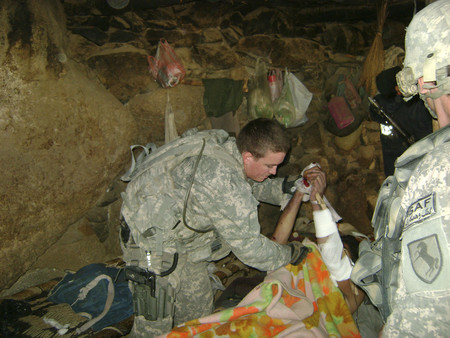Las-Vegas based National Guard unit engages militants in Afghanistan


The 700 soldiers of Nevada’s Wildhorse cavalry knew going in six months ago they would face some hairy situations in Afghanistan with roadside bombs and the reckless enemy who plants them.
Earlier this month, in a fierce encounter and the longest so far, the Las Vegas-based National Guard unit fought a deadly battle after a foiled attempt by militants who went out one night to plant improvised explosive devices, or IEDs.
When a Task Force Wildhorse patrol spotted nearly a dozen IED cell members trying to set roadside bombs, they called in an airstrike in which an F-15 fighter jet dropped a pair of bombs.
What followed was a daylong gunbattle and chase aided by remotely piloted spy planes that steered troopers through mountain villages and led them to at least one cave dwelling.
When the Dec. 6 battle ended, 15 enemy assailants had been killed but no soldiers or civilians.
"I’m proud as hell of these guys right now," Lt. Col. Scott Cunningham, commander of Nevada’s 1st Squadron, 221st Cavalry wrote in an e-mail afterward.
The unit has been conducting counter-insurgency operations, convoy security details and reconstruction support since arriving in Afghanistan in July.
The encounter took place in the Alingar district of Laghman province in northeast Afghanistan.
"We immediately followed up with ground forces and chased the survivors," Cunningham said. "Throughout the day we were in constant contact."
He said one soldier from his squadron received a minor wound when a bullet grazed him "but he continued to fight for the rest of the mission."
Capt. Blain Holmes, the squadron’s spokesman, said the militants were planting IEDs near a village when coalition forces launched the attack.
After the F-15 bombs exploded, killing six, the surviving militants fled by car, outrunning the Wildhorse’s armored vehicle up a rough, dirt road.
But Cunningham said they couldn’t outrun the high-tech video cameras of a remotely piloted Predator spy plane that was able to track their moves and relay the footage to commanders on the ground.
Nevada and Afghan national security forces searched two villages where the surviving militants had fled. They arrested two who had been wounded.
"At each house they stopped at, we would come by and capture the wounded enemy inside," Cunningham said.
Pursuing soldiers also followed a vehicle that fled the area to a cave dwelling and found a militant who was suffering from injuries from the earlier air strike.
Holmes said Task Force Wildhorse medics treated the suspect and were preparing to evacuate him "when they came under heavy fire from all directions."
One of the medics suffered a gunshot wound in the shoulder.
The soldiers responded with direct fire by calling in close air support which resulted in the killing of approximately nine more militants on a ridge.
Responding soldiers searched a nearby house and found a weapons cache, a bag of opium and five more militants who were taken into custody and turned over to Afghan security forces.
Asked whether there was any link between the Dec. 6 gunbattle-IED encounter and a similar incident that occurred in early November in the Laghman province, Holmes said he couldn’t confirm that but said the IED cell that Nevada soldiers destroyed is believed to have connections to a 2,000-pound vehicle bomb that was found in the Alingar district about three weeks ago.
"We also believe this cell is responsible for the deaths of approximately 60 Afghans, wounding of 100 more, and the killing of two coalition forces soldiers as a result of suicide and IED attacks in this area," Holmes wrote in an e-mail.
Cunningham said the success of the mission was because of "our ability to very rapidly and aggressively pursue the enemy, even in the middle of the night."
Contact reporter Keith Rogers at krogers@reviewjournal.com or 702-383-0308.












